Mark Hasegawa-Johnson
The Interspeech 2025 Speech Accessibility Project Challenge
Jul 29, 2025Abstract:While the last decade has witnessed significant advancements in Automatic Speech Recognition (ASR) systems, performance of these systems for individuals with speech disabilities remains inadequate, partly due to limited public training data. To bridge this gap, the 2025 Interspeech Speech Accessibility Project (SAP) Challenge was launched, utilizing over 400 hours of SAP data collected and transcribed from more than 500 individuals with diverse speech disabilities. Hosted on EvalAI and leveraging the remote evaluation pipeline, the SAP Challenge evaluates submissions based on Word Error Rate and Semantic Score. Consequently, 12 out of 22 valid teams outperformed the whisper-large-v2 baseline in terms of WER, while 17 teams surpassed the baseline on SemScore. Notably, the top team achieved the lowest WER of 8.11\%, and the highest SemScore of 88.44\% at the same time, setting new benchmarks for future ASR systems in recognizing impaired speech.
ProsodyLM: Uncovering the Emerging Prosody Processing Capabilities in Speech Language Models
Jul 27, 2025Abstract:Speech language models refer to language models with speech processing and understanding capabilities. One key desirable capability for speech language models is the ability to capture the intricate interdependency between content and prosody. The existing mainstream paradigm of training speech language models, which converts speech into discrete tokens before feeding them into LLMs, is sub-optimal in learning prosody information -- we find that the resulting LLMs do not exhibit obvious emerging prosody processing capabilities via pre-training alone. To overcome this, we propose ProsodyLM, which introduces a simple tokenization scheme amenable to learning prosody. Each speech utterance is first transcribed into text, followed by a sequence of word-level prosody tokens. Compared with conventional speech tokenization schemes, the proposed tokenization scheme retains more complete prosody information, and is more understandable to text-based LLMs. We find that ProsodyLM can learn surprisingly diverse emerging prosody processing capabilities through pre-training alone, ranging from harnessing the prosody nuances in generated speech, such as contrastive focus, understanding emotion and stress in an utterance, to maintaining prosody consistency in long contexts.
ConfPO: Exploiting Policy Model Confidence for Critical Token Selection in Preference Optimization
Jun 12, 2025Abstract:We introduce ConfPO, a method for preference learning in Large Language Models (LLMs) that identifies and optimizes preference-critical tokens based solely on the training policy's confidence, without requiring any auxiliary models or compute. Unlike prior Direct Alignment Algorithms (DAAs) such as Direct Preference Optimization (DPO), which uniformly adjust all token probabilities regardless of their relevance to preference, ConfPO focuses optimization on the most impactful tokens. This targeted approach improves alignment quality while mitigating overoptimization (i.e., reward hacking) by using the KL divergence budget more efficiently. In contrast to recent token-level methods that rely on credit-assignment models or AI annotators, raising concerns about scalability and reliability, ConfPO is simple, lightweight, and model-free. Experimental results on challenging alignment benchmarks, including AlpacaEval 2 and Arena-Hard, demonstrate that ConfPO consistently outperforms uniform DAAs across various LLMs, delivering better alignment with zero additional computational overhead.
SyncDiff: Diffusion-based Talking Head Synthesis with Bottlenecked Temporal Visual Prior for Improved Synchronization
Mar 17, 2025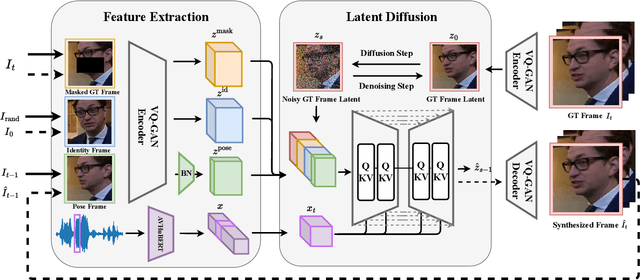
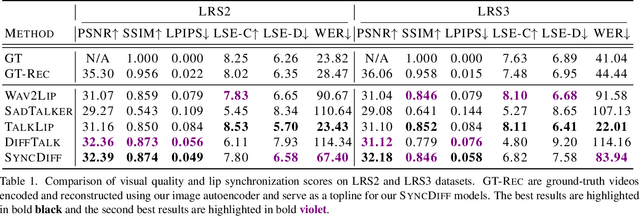

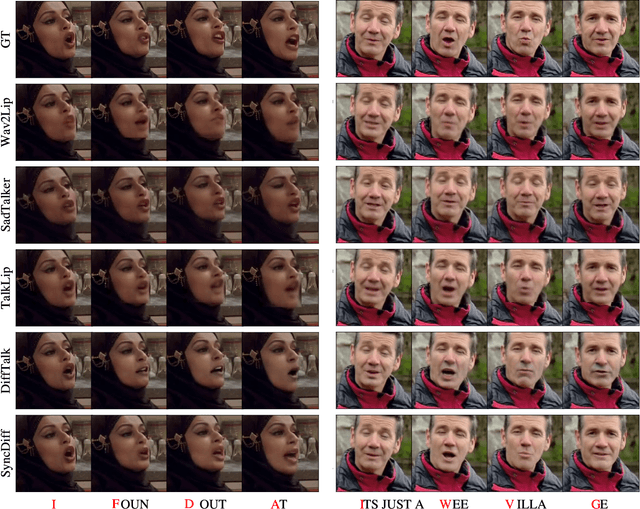
Abstract:Talking head synthesis, also known as speech-to-lip synthesis, reconstructs the facial motions that align with the given audio tracks. The synthesized videos are evaluated on mainly two aspects, lip-speech synchronization and image fidelity. Recent studies demonstrate that GAN-based and diffusion-based models achieve state-of-the-art (SOTA) performance on this task, with diffusion-based models achieving superior image fidelity but experiencing lower synchronization compared to their GAN-based counterparts. To this end, we propose SyncDiff, a simple yet effective approach to improve diffusion-based models using a temporal pose frame with information bottleneck and facial-informative audio features extracted from AVHuBERT, as conditioning input into the diffusion process. We evaluate SyncDiff on two canonical talking head datasets, LRS2 and LRS3 for direct comparison with other SOTA models. Experiments on LRS2/LRS3 datasets show that SyncDiff achieves a synchronization score 27.7%/62.3% relatively higher than previous diffusion-based methods, while preserving their high-fidelity characteristics.
Robust Cross-Etiology and Speaker-Independent Dysarthric Speech Recognition
Jan 25, 2025



Abstract:In this paper, we present a speaker-independent dysarthric speech recognition system, with a focus on evaluating the recently released Speech Accessibility Project (SAP-1005) dataset, which includes speech data from individuals with Parkinson's disease (PD). Despite the growing body of research in dysarthric speech recognition, many existing systems are speaker-dependent and adaptive, limiting their generalizability across different speakers and etiologies. Our primary objective is to develop a robust speaker-independent model capable of accurately recognizing dysarthric speech, irrespective of the speaker. Additionally, as a secondary objective, we aim to test the cross-etiology performance of our model by evaluating it on the TORGO dataset, which contains speech samples from individuals with cerebral palsy (CP) and amyotrophic lateral sclerosis (ALS). By leveraging the Whisper model, our speaker-independent system achieved a CER of 6.99% and a WER of 10.71% on the SAP-1005 dataset. Further, in cross-etiology settings, we achieved a CER of 25.08% and a WER of 39.56% on the TORGO dataset. These results highlight the potential of our approach to generalize across unseen speakers and different etiologies of dysarthria.
R2I-rPPG: A Robust Region of Interest Selection Method for Remote Photoplethysmography to Extract Heart Rate
Oct 21, 2024



Abstract:The COVID-19 pandemic has underscored the need for low-cost, scalable approaches to measuring contactless vital signs, either during initial triage at a healthcare facility or virtual telemedicine visits. Remote photoplethysmography (rPPG) can accurately estimate heart rate (HR) when applied to close-up videos of healthy volunteers in well-lit laboratory settings. However, results from such highly optimized laboratory studies may not be readily translated to healthcare settings. One significant barrier to the practical application of rPPG in health care is the accurate localization of the region of interest (ROI). Clinical or telemedicine visits may involve sub-optimal lighting, movement artifacts, variable camera angle, and subject distance. This paper presents an rPPG ROI selection method based on 3D facial landmarks and patient head yaw angle. We then demonstrate the robustness of this ROI selection method when coupled to the Plane-Orthogonal-to-Skin (POS) rPPG method when applied to videos of patients presenting to an Emergency Department for respiratory complaints. Our results demonstrate the effectiveness of our proposed approach in improving the accuracy and robustness of rPPG in a challenging clinical environment.
Fine-Tuning Automatic Speech Recognition for People with Parkinson's: An Effective Strategy for Enhancing Speech Technology Accessibility
Sep 29, 2024
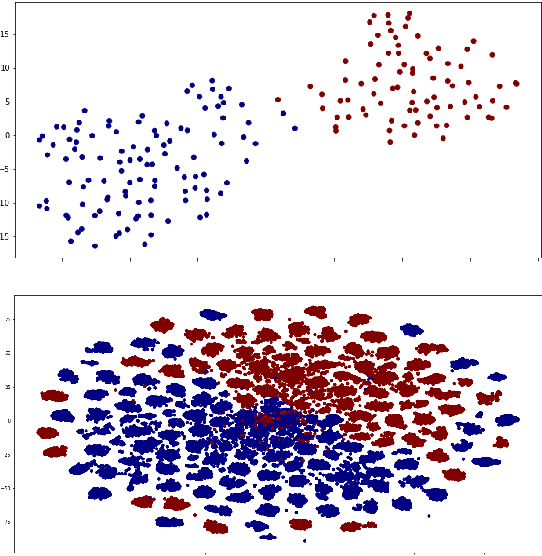

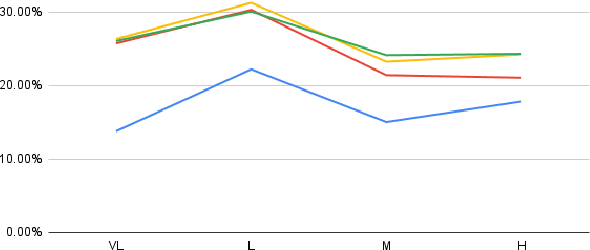
Abstract:This paper enhances dysarthric and dysphonic speech recognition by fine-tuning pretrained automatic speech recognition (ASR) models on the 2023-10-05 data package of the Speech Accessibility Project (SAP), which contains the speech of 253 people with Parkinson's disease. Experiments tested methods that have been effective for Cerebral Palsy, including the use of speaker clustering and severity-dependent models, weighted fine-tuning, and multi-task learning. Best results were obtained using a multi-task learning model, in which the ASR is trained to produce an estimate of the speaker's impairment severity as an auxiliary output. The resulting word error rates are considerably improved relative to a baseline model fine-tuned using only Librispeech data, with word error rate improvements of 37.62\% and 26.97\% compared to fine-tuning on 100h and 960h of LibriSpeech data, respectively.
Just ASR + LLM? A Study on Speech Large Language Models' Ability to Identify and Understand Speaker in Spoken Dialogue
Sep 07, 2024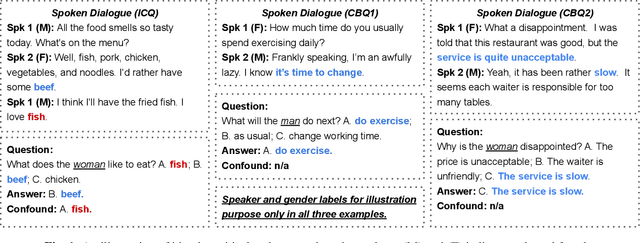
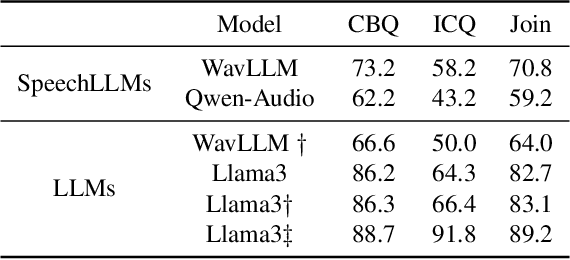
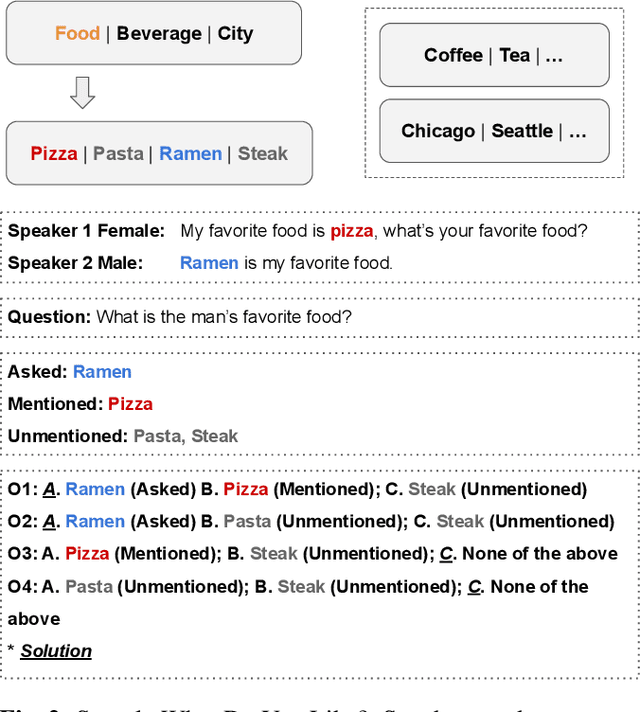
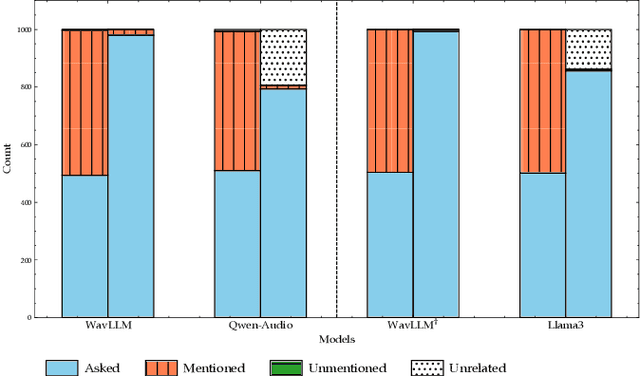
Abstract:In recent years, we have observed a rapid advancement in speech language models (SpeechLLMs), catching up with humans' listening and reasoning abilities. Remarkably, SpeechLLMs have demonstrated impressive spoken dialogue question-answering (SQA) performance in benchmarks like Gaokao, the English listening test of the college entrance exam in China, which seemingly requires understanding both the spoken content and voice characteristics of speakers in a conversation. However, after carefully examining Gaokao's questions, we find the correct answers to many questions can be inferred from the conversation context alone without identifying the speaker asked in the question. Our evaluation of state-of-the-art models Qwen-Audio and WavLLM in both Gaokao and our proposed "What Do You Like?" dataset shows a significantly higher accuracy in these context-based questions than in identity-critical questions, which can only be answered correctly with correct speaker identification. Our results and analysis suggest that when solving SQA, the current SpeechLLMs exhibit limited speaker awareness from the audio and behave similarly to an LLM reasoning from the conversation transcription without sound. We propose that our definitions and automated classification of context-based and identity-critical questions could offer a more accurate evaluation framework of SpeechLLMs in SQA tasks.
LI-TTA: Language Informed Test-Time Adaptation for Automatic Speech Recognition
Aug 11, 2024Abstract:Test-Time Adaptation (TTA) has emerged as a crucial solution to the domain shift challenge, wherein the target environment diverges from the original training environment. A prime exemplification is TTA for Automatic Speech Recognition (ASR), which enhances model performance by leveraging output prediction entropy minimization as a self-supervision signal. However, a key limitation of this self-supervision lies in its primary focus on acoustic features, with minimal attention to the linguistic properties of the input. To address this gap, we propose Language Informed Test-Time Adaptation (LI-TTA), which incorporates linguistic insights during TTA for ASR. LI-TTA integrates corrections from an external language model to merge linguistic with acoustic information by minimizing the CTC loss from the correction alongside the standard TTA loss. With extensive experiments, we show that LI-TTA effectively improves the performance of TTA for ASR in various distribution shift situations.
Sound Tagging in Infant-centric Home Soundscapes
Jun 25, 2024



Abstract:Certain environmental noises have been associated with negative developmental outcomes for infants and young children. Though classifying or tagging sound events in a domestic environment is an active research area, previous studies focused on data collected from a non-stationary microphone placed in the environment or from the perspective of adults. Further, many of these works ignore infants or young children in the environment or have data collected from only a single family where noise from the fixed sound source can be moderate at the infant's position or vice versa. Thus, despite the recent success of large pre-trained models for noise event detection, the performance of these models on infant-centric noise soundscapes in the home is yet to be explored. To bridge this gap, we have collected and labeled noises in home soundscapes from 22 families in an unobtrusive manner, where the data are collected through an infant-worn recording device. In this paper, we explore the performance of a large pre-trained model (Audio Spectrogram Transformer [AST]) on our noise-conditioned infant-centric environmental data as well as publicly available home environmental datasets. Utilizing different training strategies such as resampling, utilizing public datasets, mixing public and infant-centric training sets, and data augmentation using noise and masking, we evaluate the performance of a large pre-trained model on sparse and imbalanced infant-centric data. Our results show that fine-tuning the large pre-trained model by combining our collected dataset with public datasets increases the F1-score from 0.11 (public datasets) and 0.76 (collected datasets) to 0.84 (combined datasets) and Cohen's Kappa from 0.013 (public datasets) and 0.77 (collected datasets) to 0.83 (combined datasets) compared to only training with public or collected datasets, respectively.
 Add to Chrome
Add to Chrome Add to Firefox
Add to Firefox Add to Edge
Add to Edge